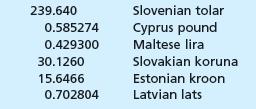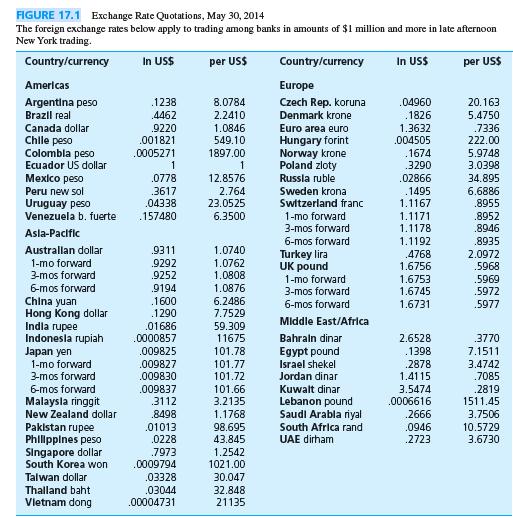One of the currencies shown in Figure 17.1 was not there in the mid-1990s. On January 1,
Question:
One of the currencies shown in Figure 17.1 was not there in the mid-1990s. On January 1, 1999, a major new currency, the euro (€ ), was born. The European Union (EU) created the euro, and 11 of the 15 EU countries began using it immediately, with Greece joining the club on January 1, 2001. For several years after the euro’s birth in 1999, both the euro and the national currencies of these countries coexisted.
Then, during the first two months of 2002, the national currencies of these 12 countries were completely replaced by the euro. The conversion rates were that 1 euro replaced each of

Subsequently, Slovenia joined the euro area in 2007, Cyprus and Malta in 2008, Slovakia in 2009, Estonia in 2011, and Latvia in 2014, so that 1 euro has also replaced each of

As recently as the late 1980s, the idea of merging the EU national currencies seemed like science fiction. But, in 1991, the EU countries drafted the Maastricht Treaty, and it became effective in 1993 after all EU countries approved it, some by close national votes. The Maastricht Treaty set a process for establishing a monetary union and a single unionwide currency, including a timetable and criteria for a country to join. But the system that preceded the euro, the Exchange Rate Mechanism of the European Monetary System, came under severe pressure in 1992–1993 and nearly collapsed.
Monetary union still looked far away.
The national governments persisted, and people began to believe. In early 1998, 11 EU countries were deemed to meet the five criteria, covering each country’s inflation rate, long-term interest rate, exchange-rate value of its currency, government budget deficit, and government debt. Three countries—the United Kingdom, Denmark, and Sweden—could have met the criteria but chose not to join the euro. Each had serious political concerns about the loss of national power and the loss of the national money as a symbol. The other EU country at that time, Greece, did not meet the criteria at first but joined two years later.
The euro is now one of the three major world currencies, along with the U.S. dollar and the Japanese yen. It is part of the growing integration within the EU, a process that also includes the “Europe 1992” drive for a single European market. The euro came under stress in 2010 and 2011 when rescue loans had to be granted to the governments of, first, Greece and then several other euro countries. In later chapters we will examine the implications of the euro for the macroeconomic performance of the EU countries.
DISCUSSION QUESTION You are a Japanese citizen about to travel to France, Italy, and Slovenia for a vacation. Are you happy or unhappy that the euro exists?
Data From Figure 17.1

Step by Step Answer:






